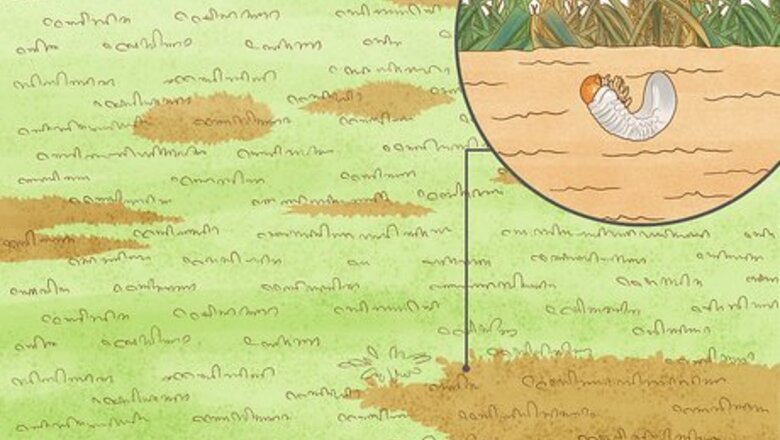
views
Treating Grubs Naturally
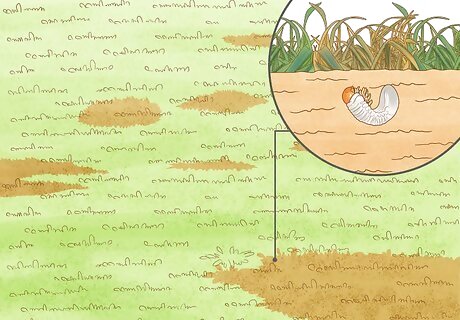
Look for signs of grubs. One of the major signs of a grub infestation is irregularly shaped brown patches of dead grass, but that can be caused by a number of different factors as well. If you think you may have grubs, look for other signs as well, including: Holes in your lawn caused by birds and mammals digging in the grass to get to the grubs Grass with no roots A spongy feeling when you touch or walk on the lawn
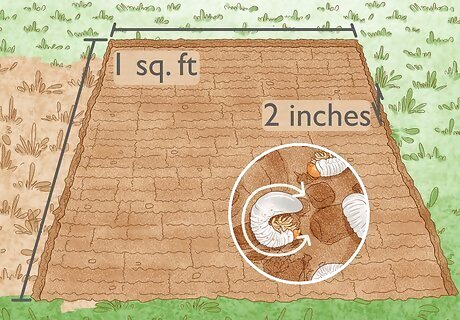
Check for grubs. When you do find evidence of grubs, the next step is to search your lawn to inspect for the larvae. To do this, find a small spade or shovel and go to one or two of the dead patches of grass. Dig up square-foot (30 cm by 30 cm) portions of lawn where the dead grass meets the green grass Dig to a depth of about two inches (five cm) Look for C-shaped bugs with legs on the inside of the body near the head If you find these larvae, it means you have grubs
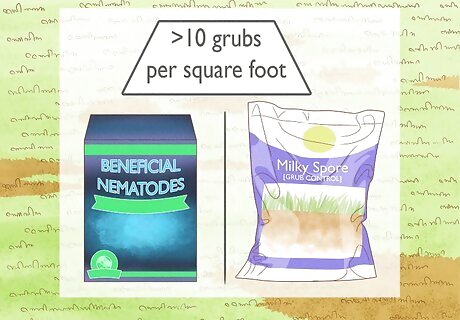
Decide if you need to treat. Even if you find grubs in your lawn, it’s possible that you may not have to get rid of them, depending on how many there are. A few grubs aren't actually going to hurt your lawn or cause too much cosmetic damage, especially if your lawn is healthy. There is no need to take action to get rid of the grubs if you find fewer than five per square foot. If you find more than five but fewer than 10 grubs per square foot, you'll only need to treat your lawn if your grass isn't healthy. Regardless of the state of your lawn, you'll need to get rid of the grubs if you find more than 10 per square foot.
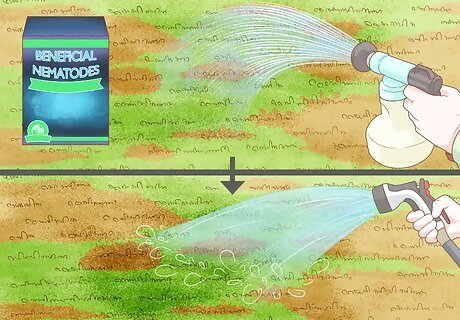
Use beneficial nematodes to get rid of any type of grub. The scientific name for these is Heterorhabditis bacteriophora, and they are microscopic, parasitic worms that invade grubs and release bacteria that kill them. It’s important to note, however, that this is a long-term method, and it can take the worms up to three years to fully control your grub problem. For the best results, apply the beneficial nematodes in the late afternoon, and water the lawn immediately after applying them. Because beneficial nematodes need to invade the bodies of grubs in order to propagate, you must choose between using this method or using a chemical pesticide. These worms may be sold under the name Hb nematodes, and you can buy them through gardening stores, catalogues, and online.
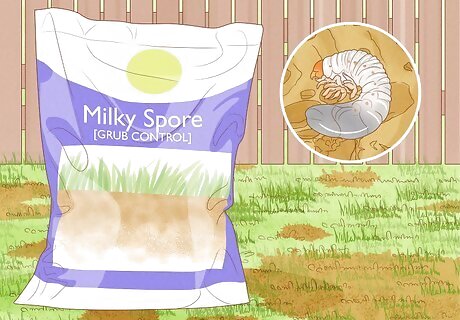
Use spores for Japanese beetle grubs. Bacillus popilliae is a bacterium that can be used to kill the larvae of Japanese beetles. Because it’s a spore, it comes in the form of a powder that you can sprinkle on your lawn to get rid of grubs. Like the worms, using Bacillus popilliae to get rid of grubs is a long-term solution, rather than a quick fix. To use Bacillus popilliae, you can spray it onto your lawn with water, or sprinkle the dry powder onto your grass. Like the beneficial nematodes, you'll have to choose between using Bacillus popilliae or chemical pesticides, because the spores won’t work without a grub population. A Japanese beetle grub can be distinguished from other grubs by the end of its body. Whereas most grub bodies end in a rounded stump, the Japanese beetle grub has a pointed end.
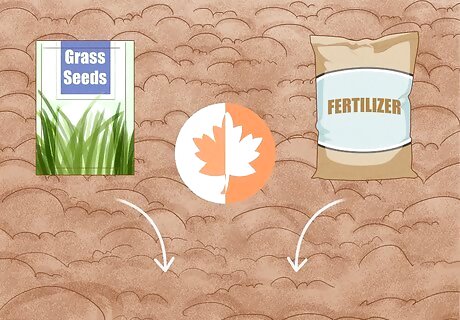
Seed and fertilize your lawn in the fall. Beetles don’t tend to lay eggs in grass that’s long and thick. By seeding and fertilizing your lawn, you can repair any damage the grubs have done and deter new beetles from laying more eggs. In spring and fall, rake away dead grass from any brown patches. Water your lawn, then sprinkle new grass seed over any thin or dead areas. After reseeding, fertilize the lawn to help the dead patches regenerate and the new seeds to thrive.
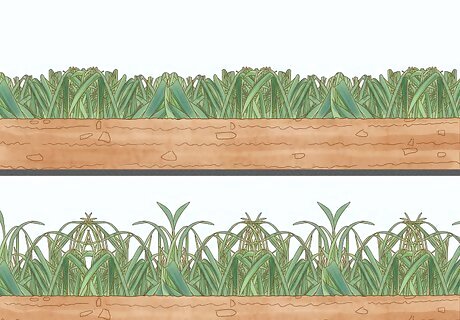
Let your lawn grow long. Because beetles don’t like long grass either for egg-laying, let your grass grow longer than you might otherwise once it starts to grow back. Keep your grass about two inches long. Raise the blades on your lawnmower to increase the length that it will cut the grass.
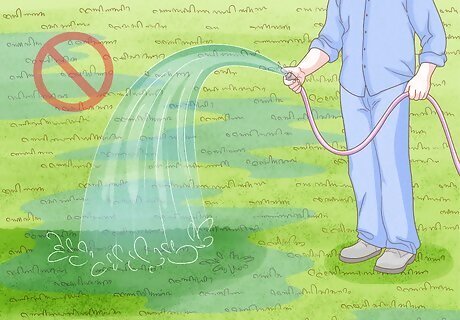
Don’t overwater. An easy way to prevent your lawn from becoming a breeding ground for grubs is by letting it dry out or watering it as little as possible. Beetle eggs will die without water, so starving them of it will kill the eggs before they even hatch into grubs. Many grubs lay eggs in July, so it’s especially important to keep your lawn dry in July and August. Beetles will also avoid laying eggs in a dry lawn, so you should consider not watering your lawn in the last week of June as well.
Treating Grubs With Synthetic Pesticides
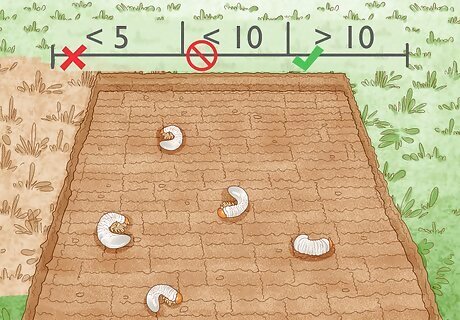
Determine if a synthetic pesticide is necessary. Synthetic pesticides can be quite strong, dangerous to apply, and damaging to the environment. To ensure it’s necessary to treat your lawn at all, first determine if you have grubs, and then decide if the problem is big enough to require treatment. Look for indications that there are grubs in your lawn, such as holes, grass with no roots, browning patches, and patches that feel spongy. To determine for sure if you have grubs, dig up a square-foot (30 cm by 30 cm) patch of grass to a depth of two inches (five cm) and look for grubs. Don’t treat your lawn if there are fewer than five grubs, and avoid treating if your lawn is healthy and you find fewer than 10. If there are 10 or more grubs, treat your lawn.
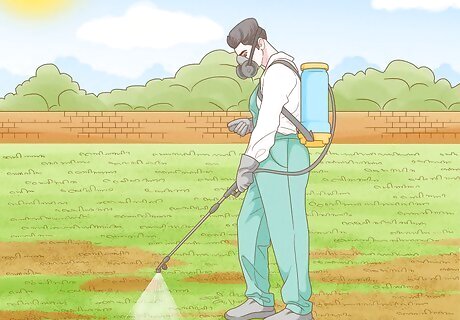
Try a synthetic pesticide for all grubs. When you’ve gone through and determined for certain that you have grubs and need to treat, you can use a curative pesticide that will kill grubs almost immediately. The two types of curative pesticides you can use are carbaryl and trichlorfon (sold under the brand name Dylox). Water your lawn both before and after applying the pesticide to ensure that the chemical sinks in to the soil to where the grubs are. Apply curative pesticides to your lawn in fall, spring, and before May. You can find these types of pesticides in home and hardware stores. Make sure you wear gloves, a protective mask, and other safety gear when applying pesticides.
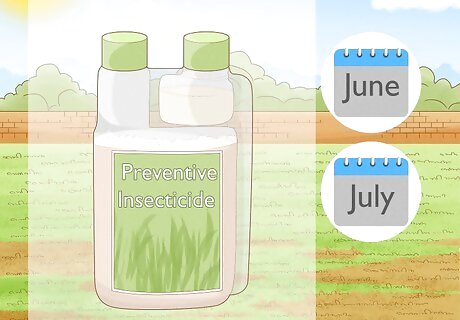
Apply a preventive insecticide for next year. There is another type of pesticide that can help control grubs, and it’s a preventive pesticide that’s meant to kill upcoming generations. Typically, this type of pesticide is applied in June or July, after you’ve already sprayed with a curative pesticide. To protect pollinators such as bees from the pesticide, mow your lawn to remove flowering weeds before applying the product. To stop your grass from burning, water your lawn thoroughly all summer after applying the insecticide. Preventive pesticides include those sold under the brand names Merit and Mach 2.
















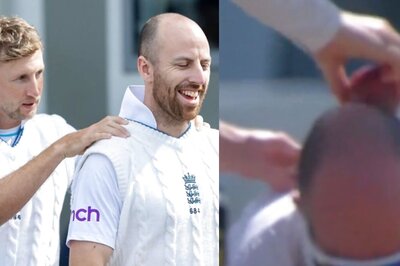
Comments
0 comment